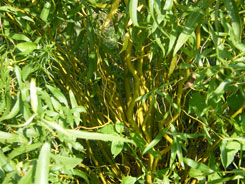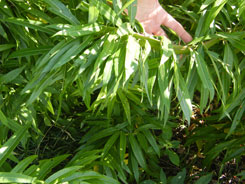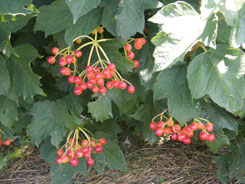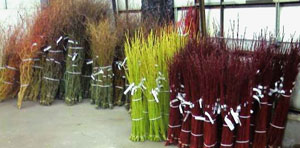
The Idea
In 1999 Dr. Scott Josiah, state forester and director of the Nebraska Forest Service, started some research through the University of Nebraska—Lincoln on the idea of alley cropping and alley conservation, to provide wind protection, soil erosion and moisture stabilization by placing a row of woody florals within a cultivated field. This research project was conducted through UNL sites at Mead and Concord and collaboration with Arbor Farms. This research led to studies involving harvesting and market potential in the wholesale floral markets for the stems of the plants grown.
About eight years ago, a group of area farmers, graduate students and floral designers became interested in woody floral production as an alternative agriculture crop. They completed research on which plants are best suited for Nebraska climates, the optimum harvest standards and which stems were marketable. This research led to a steering committee that set up several meetings over a six month period to formalize their ideas. They discussed setting up as a marketing cooperative and what that would entail for growers and/or members of the cooperative. After several exploratory meetings, the committee decided to pursue the business model of a cooperatively owned marketing business for woody floral stems. The steering committee consisted of: Bruce Bostelman, Eric Nelson, Linda and Fran Hangren.
The committee eventually applied for a USDA grant to develop the business framework, but was unsuccessful. In 2005 they received the Nebraska Cooperative Development Center (NCDC) Initial Assistance Grant that helped them with assessment of: markets, development groups competitive advantage and processing issues; along with completing a feasibility study, organizational/legal structure and developing a business and marketing plan. They traveled to Omaha, Lincoln, Chicago, Denver and Kansas City to conduct the feasibility study through research on similar businesses. During this process Bostelman and Nelson did most of the original marketing for NWF where they found that the stems ‘basically sold themselves’ after potential buyers saw them first hand. This grant enabled the steering committee to officially found Nebraska Woody Florals Nonstock Cooperative (NWF) in September 2005.
NWF started with 24 members and five board members: Bruce Bostelman, Linda Hangren, Eric Nelson, Jan Maneely, and Gary Samuelson.
In 2006 NWF received a second grant from NCDC, Advance Assistance Grant, to help execute a marketing plan. The marketing plan included brand awareness, expanding/increasing wholesale customers, education and promotion and research and product development.
NCDC also assisted with providing guidance and direction, education both via director training programs and individual board training and business counseling. Bostelman said Jim Crandall, NCDC Associate Director, helped with some of their initial talks and was always willing to answer personnel questions and offer general guidance.
“One of the main reasons we are where we are is because of Jim Crandall through NCDC. Without that first grant from NCDC [we] wouldn’t exist today.”
-Eric Nelson
In 2007 NWF received a Specialty Crop Block Grant from the Nebraska Department of Agriculture to assist with market expansion and increasing brand awareness. For the first few years NWF grew and harvested the stems or perennials at UNL’s Mead site. The initial packaging and shipping work was done out of Bostelman’s and Nelson’s sheds.
Then in 2008 NWF utilized grant funding to purchase a building to operate out of and some land to grow on, at Mead. This building is used to process, package and ship the entire crop after harvest, as well as, houses their one part-time employee. NWF worked with several technical advisors through UNL to assist with details of growing, fertilizing, harvesting, etc at Mead.
“I feel that Nebraska Woody Florals is important to Nebraska agriculture because of [the added] diversification.”
-Troy Pabst
One of the advisors, Troy Pabst, also continued UNL’s research of woody florals into new plant varieties for the woody floral industry. He partnered with several NWF members to utilize a SARE grant for this research.
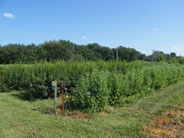
In 2009 they received the Agricultural Opportunities and Value-Added Partnership Grant to help purchase new research plant materials and equipment, expand market development and increase member education and assistance.
NWF has grown in size from 24 members in 2005 to 32 members in 2007 to 44 members currently. The number of sales and receipts also grew with-in those first years; each year showed a significant increase that sometimes doubled from year to year.
The Business
NWF is a grower owned cooperative that specializes in marketing its members’ specialty crop products by adding value to its growers' plantings. “Woody Florals” is a trade name for stems grown on perennial plants that have unique qualities that are attractive in the fresh cut floral and designer markets. Nebraska Woody Floral members grow 20 or more different varieties including: dogwoods, willows and flowering branches that are used for container and floral designs. They come in many different colors including, green, orange, watermelon, mahogany, yellow and red.
The members of NWF receive training and education on how to properly care for and grow their plants/stems. This is to help educate its growers on the proper techniques in growing plantings for commercial production. This calls for members taking good care of their crops so they receive optimum production. If a grower does not care for the plants/stems as they should then they’ll receive a significant reduction in stems produced per plant and a reduction in stem quality. NWF always strives for premium stems that are unchallenged in today’s markets.
NWF Products: Curly Willow, Pussy Willow, Flame Willow, Scarlet Curls Willow, Cardinal Dogwood, Red Twig Dogwood, & Yellow Twig Dogwood
Woody floral stems may be grown in areas that are fallow or unsuited for other row crops. Fields that may hold water where row crops won’t grow as well is one example of how growing woody florals can better utilize a farming area. The plants can also provide for a natural filtration system, enhance water quality and reduce soil erosion. These plants are considered row crops so the producers do not lose any base acres by growing them in cultivated fields that may be marginal for corn or beans.
NWF members plant both bare root plants and cuttings. The cuttings take about three years of growth before they can be harvested, while the bare root plantings may be harvested after about one year. The bare root plants and cuttings are planted during the spring and harvested in late fall to early winter; with emphasis on harvest in late October. The bulk of sales for woody stems occur from winter through spring, starting around November. NWF begins their season with bulk orders from garden centers but then the wholesale orders come in weekly according to what the business needs.
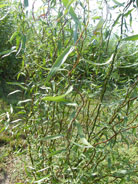
NWF currently sells in Nebraska, Kansas, Missouri and some in Denver. The members of NWF all grow their plants/stems on small farms located in the eastern one third of Nebraska; from Grand Island going east and Falls City going north. Bostelman commented that one of the benefits of having members in different locations is that they don’t all experience the same growing season; some may have better weather or growing conditions than others at different times. This way there is always at least one grower who has a crop ready when needed.
Bostelman believes woody florals are a great addition to Nebraska because of their easy growing, aesthetic value and the additional revenue. He said he continues to grow them because it’s a crop that brings money into the farm during winter when normally there’s no income. Bostelman added that the final product being sold to florists and designers are beautiful. They can add size, shape and color to any floral arrangement or container design and are easy to manage.
The Challenges
NWF has faced challenges similar to other cooperatively-owned businesses, but they also face several yearly and seasonal challenges. Nelson said their main challenges in the beginning were deciding what they wanted to become, how they were going to sell, who they would sell to, where and how to process their stems and other first-stage questions they worked through. Nelson said the exciting part was that they were starting a new business in Nebraska.
“[The best part about working with NWF] is probably the team effort between the board and the members. Basically creating a new business.”
-Eric Nelson
There are currently four main challenges NWF is working through: member participation, working with a perishable item, communication between board members and committees and the current economy.
When asked what advice he would give to anyone wanting to start a similar cooperatively-owned business Bostelman said to ‘make darn sure it’s something you want to do’. He also said that understanding group dynamics is the key; not everyone is going to get along and you have to know how to work through problems and work with people. Jan Bostelman, original NWF member, also advised new entrepreneurs to do their research because ‘you have to know your product to sell it’.
Aside from the business itself, the last couple years have created some weather challenges for the members during the growing season. Frost is a must for many of the plants/stems grown by NWF; but it needs to arrive by mid-October to be affective. Bostelman explained that the frost causes the leaves to drop off the stems naturally, something they have to do by hand or with organic chemicals otherwise. Other unique challenges they face are hail, an over abundance of rain and grasshoppers. This past season in Nebraska saw an increase in rain compared to the last couple years, which caused flooding issues for some growers. Bostelman said that the majority of his planting looked like a lake on a couple occasions.
The Future
NWF recently received a NCDC Advanced Assistant Grant to help rework their website (www.nebraskawoodyflorals.com) and develop new marketing and promotional items. They are eventually planning on expanding their current building of operation in Mead and future plans may include a second building and more employees as the business grows. Developing new markets and gaining new customers is an ongoing goal for NWF. They are working on educating retailers and consumers on the many benefits of using woody floral branches in arrangements along with the importance of their products being fresh and locally grown.
“We have a really great product that we can grow here,” Said Bostelman. “It could be an FFA project or provide additional revenue for acreage owners. It is great for the environment and people love using it in their arrangements.”
For more information on Nebraska Woody Florals, please visit their website at: www.nebraskawoodyflorals.com
